Though a spectacular attempt to cross the Antarctic Continent on foot did not succeed, Shackleton’s 1914-1916 expedition was a triumph of bravery and endurance
EPICS OF EXPLORATION - 4
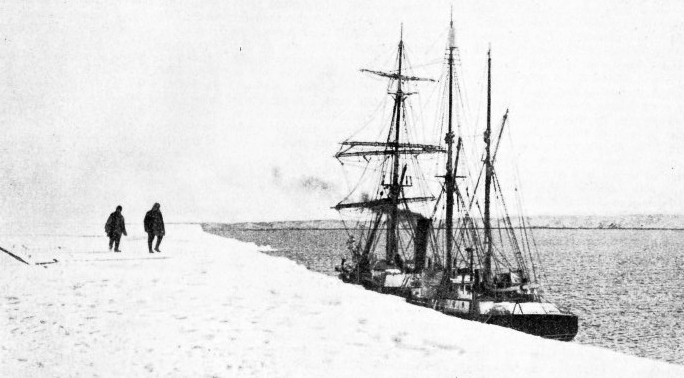
THE CALL OF ADVENTURE summoned Sir Ernest Shackleton south again in 1914. This was five years after the conclusion of his 1907-1909 expedition to the Antarctic in the Nimrod, seen above. For his 1914 expedition Shackleton took a new ship, the Endurance. A second vessel the Aurora, was intended to act as a supply ship for the latter part of the proposed trans-Antarctic journey.
ON New Year’s Day, 1914, Sir Ernest Shackleton published the plan of his second Transcontinental Antarctic Expedition. He proposed to attempt the most spectacular feat remaining to be accomplished in the Antarctic - the crossing of the continent, by a party on foot, from the Weddell Sea to the Ross Sea via the South Pole.
A new ship, the Endurance, was to take Shackleton’s party to the Weddell Sea and land them as far southward as possible. If they reached there early enough in the season, the transcontinental journey would be begun immediately. In that event the party should have been at the South Pole by January, 1915. Meanwhile a second vessel, the Aurora, would have landed in McMurdo Sound (Ross Sea) a supporting party which would lay depots of food and fuel as far southward as the Beardmore Glacier (83½° S.). These would be picked up by the transcontinental party on the northward half of their march, as it was impracticable for them to start with sufficient food for the whole journey.
If the transcontinental party could not be landed in time to attempt the crossing with any hope of success before the Antarctic winter of 1915, they would start as early as possible in the latter half of that year. The depots, of course, would be equally valuable in either contingency.
Such was the plan. It was never realized, and perhaps never will be. But Shackleton’s attempt led to a series of hairbreadth escapes and adventures so remarkable that, if published as fiction, they would probably have met with the criticism that “such things don’t happen in real life”.
By the end of July, 1914, the Endurance was ready to sail from England. But the war-clouds were gathering fast, and on August 4, Shackleton wired to the Admiralty offering to place ship, stores and crew’ at its disposal in the event of war. A laconic “Proceed”
was received within an hour, followed by a later message saying that the authorities wished the expedition to go ahead as planned. Accordingly, the Endurance sailed from Plymouth on September 8. The Aurora, already much nearer the scene of her operations, was not due to leave Hobart (Tasmania) till Christmas.
The Endurance left South Georgia on December 5, 1914, and stood southward into the Weddell Sea - probably the most dangerous in the world. The winds there are generally light, so that new ice can accumulate in huge masses even during summer. The currents, on the other hand, are strong, and sweep the ice-fields - more or less solid masses often many thousands of square miles in area - in a clockwise orbit covering the whole extent of the Sea. These icefields exert remorseless pressure upon any ship unfortunate enough to be caught in them or between them and the coast. Only once - in 1823, the year of its discovery - has the Weddell Sea been found clear of ice; since then few ships have ever entered it, and fewer still have come out unscathed.
At first all went well. The Endurance met the pack-ice off the South Sandwich islands - discovered by Captain Cook in 1775 - and threaded her way gingerly through it, heading for Coats Land - the south-eastern shore of the Weddell Sea, first seen by Bruce in 1904. She came in sight of this on January 10, 1915. Two days later she was skirting a new discovery - a huge ice-barrier attached to new land connecting Coats Land with Luitpold Land (discovered by Filchner in 1912). Shackleton named this “Caird Coast” after Sir James Caird, one of the expedition’s warmest supporters.
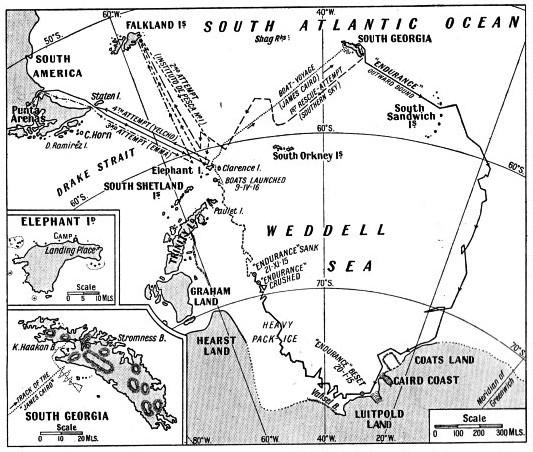
ONE OF THE WORLD’S MOST PERILOUS SEAS, the Weddell Sea, is shown here. Strong currents impel the vast icefields, which are capable of crushing any ship caught in them. Shackleton's vessel, the Endurance, was trapped on January 19, 1915. In October of that year the ship had to be abandoned. Shackleton with his twenty-seven men camped on the ice for a while near the doomed ship. Later, moving north on ice-floes, the party reached Elephant Island in April, 1916, after a desperate struggle.
On January 15 they passed, regretfully, a most excellent landing-place about a hundred miles north-eastward of Vahsel Bay, for which Shackleton was aiming. The chance never recurred, for on the night of January 19 the pack-ice closed firmly round the ship - and by next morning she was helplessly beset. Attempts to break her out with the engines had no successs: and after ten days Shackleton let his fires die out to save coal. They were too far from land to think of sledging their stores and provisions over the intervening ice; and unless some providential gale should break up the ice within the next few days they might look forward to spending at least six months in the pack. Possibly the succeeding spring might see the Endurance liberated in condition to make a fresh attempt, but no one could say where the winds and currents would drift them in the meantime, or whether the ship could withstand the heavy ice-pressure.
The Loss of the “Endurance”
Shackleton did all he could to safeguard his ship and keep his men efficient. Huts were built on the floes alongside for the expedition’s sixty sledgedogs, which were exercised whenever possible. All stores were checked and re-stowed; the “’tween-decks” space was converted into living-quarters. The boilers were emptied to save the coal necessary to keep them from freezing. As many seal as possible were killed and stored to eke out the provisions and fend off scurvy. By the middle of March all hands had settled down to winter routine.
The Endurance drifted slowly northward. Although both she and the Aurora carried wireless, neither succeeded, while in the Antarctic, in sending an intelligible message, or in picking one up from any outside source. If they could have communicated, Shackleton would have learned that the Aurora was in the same plight as himself. After the depot-laying party had landed at Ross Island the Aurora was blown away from her winter moorings in McMurdo Sound on May 6. 1915, and immediately beset. By mid-winter (June, 1915) both ships, on opposite sides of the South Pole, were in about 74° S., drifting slowly northward with no immediate prospect of release.
In July the Weddell Sea ice became ominously active. Formidable ridges showed in the pack, indicating that it was being forced up by heavy pressure., One such region appeared quite suddenly not more than three hundred yards from the ship. Enormous masses of ice were piled up in wild confusion. Shackleton had made preparations to abandon ship in the event of emergency, and on August 1, 1915 - the anniversary of their departure from West India Docks, London - it looked as if this would have to be done. The floes all round suddenly cracked under heavy pressure, and the ship heeled wildly over to starboard, while huge blocks of ice rose out of the floes “like cherry-stones squeezed between thumb and finger”. Apart from a battered rudder the Endurance sustained little damage, and two days later the ice had frozen firmly round her again.
October, however, saw the beginning of the end. They were then about 69° S. 51° W. - in the most ice-congested portion of the whole Weddell Sea. On October 18 their predicament of August was almost exactly repeated; and on October 24 a renewal of heavy pressure at last started some of the ship’s sorely-tried, timbers, and she began to leak dangerously. For a time, incessant hand-pumping kept the leaks in check; but there was no respite from the pressure, and by October 26 it was clear that the Endurance was doomed. Shackleton ordered all boats, gear, provisions and sledges to be lowered on to the floes and removed to a short distance from the ship. All that night, hoping against hope, they went on pumping; but in the afternoon of October 27 the rudder-post and stern-post were torn bodily out, the decks began to break upwards, and the sea poured in through several gaping rents in the hull. In accordance with tradition, Shackleton was the last man to leave the ship. Just before doing so, he looked down through the engine-room skylight and saw the engines falling bodily sideways as the bedplates and stays gave way and snapped. It was a pitiable sight.
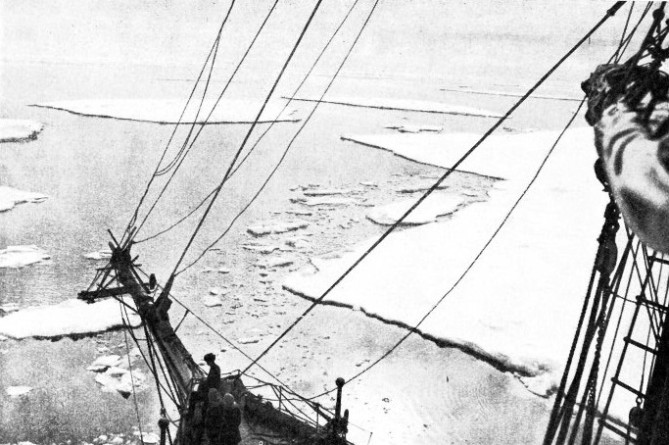
“NATURE’S GIGANTIC JIGSAW PUZZLE” is how Shackleton described pack-ice, of which there are several kinds. “Loose pack” is ice which has floated apart, and “close pack” that which is so congested as to form a surface - often extending for miles - upon which it is possible to walk. “Very open pack”, which is similar to drift-ice, is shown above. This photograph was taken from the Endurance while she was on the northern edge of the ice pack. Eventually the vessel was crushed by the enormous pressure of the ice and lost.
“The Boss”, as his men delighted to call him, was facing a situation grim beyond all precedent. His ship was lost. His twenty-seven men were encamped, hundreds of miles from all possible help, on drifting floes that would ultimately break up. No one else in the world knew, or could discover, where they were or what had happened to them. They had only a limited supply of food and fuel, and were exposed to the full rigour of the Antarctic winter.
But Shackleton was one of those born leaders whom no emergency can surprise and no difficulty baffle. He mustered his men, and told them that, after overhauling the stores and discarding all superfluous gear, the party would sledge their way northward over the floes. They would take the ship’s three boats with them. Their objective would be Paulet Island (some 350 miles to the north-westward), where a hut, still containing stores, had been erected for the Swedish Antarctic Expedition of 1902. The northerly drift of the floes would help them on their way; and when they reached the edge of the pack - or before, if it broke up - they would take to the boats. If they would work their utmost, and trust him, he had no doubt that all would eventually reach safety. It was a bold statement, but his reputation - and the event - justified it.
Drifting Northwards
By hard sledging the men contrived to shift their tents, provisions, the three boats, and their personal belongings (sternly reduced to a maximum of 2 lb. a man) to a thick, heavy old floe about a mile and half from what was left of the Endurance. At this camp (“Ocean Camp”) they stayed nearly two months, the labour of sledging even this tiny distance having shown that such slow progress was not worth the labour it entailed. They lived, as far as possible, on seal and penguins, reserving their provisions - full rations for twenty-eight men for fifty-six days - for the inevitable boat-voyage. On November 21, 1915, the crushed Endurance lifted her stern high in the air and went down - snapping, so it seemed to them, their last link with the outer world. Their spirits, however, were cheered by the periodical observations secured by Worsley, the Endurance’s captain; for these showed a more or less steady drift northward.
On December 23 Shackleton made a final effort to speed up their progress by sledging - but a week’s pulling carried them only seven and a half miles in a direct line. They had several times been in great danger, floes on which they had rigged their tents for the night having more than once cracked to pieces under them. On December 30 the party camped at “Patience Camp” and remained there for three and a half months.
Worsley’s observations had gradually revealed that they could not hope to make Paulet Island. On March 17 they were sixty miles due eastward of it - in the heavy ice-conditions prevailing, this distance might as well have been 600 miles. By now food was woefully short, and all hands were weakening in consequence.
On April 7, 1916, at daylight, came a welcome sight - land at last. It was the high peak of Clarence Island, the northernmost of the S. Shetlands, more than sixty miles away. A little later the summits of its western neighbour, Elephant Island, appeared also. Here was comparative safety, if only they could reach it.
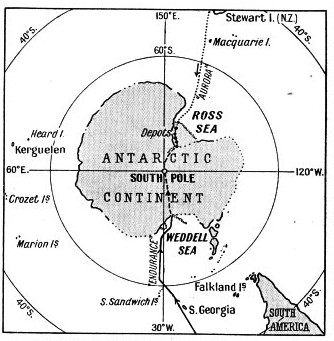
THE PLANNED ROUTES of the Expedition’s two parties are shown on this map. The Endurance was to take Shackleton’s party to the Weddell Sea and land it as near the Pole as possible. It would then make the transcontinental journey via the South Pole. A supporting party was to proceed at the same time in the Aurora, land at McMurdo Sound in the Ross Sea and lay depots of food and fuel, to be picked up by the first party on the northward section of their journey.
By now the floe on which the survivors of the Endurance were camped was not far from the seaward edge of the pack, and they could feel it lifting to the never-ceasing Antarctic swell. On April 8 the floe split in two, leaving the party on a triangular ice-raft, the sides of which measured roughly 90, 100 and 120 yards. Next morning it split again - the crack running through Shackleton’s own tent and right under the months-old site of his sleeping-bag. Their floating home would serve no longer. After a hasty meal the three little boats - the Dudley Docker, Stancomb Wills and James Caird, each named after one of the expedition’s benefactors - were launched and manned. Almost immediately they were all but capsized in a furious tide-rip. Clearing this by great exertion, the party made for a safer-looking floe, and hauled the boats up for the night.
About eleven that night the new floe suddenly split and one man (Holness) fell down the crack in his sleeping-bag. Shackleton, first on the scene, gripped man and bag and, with a mighty heave, swung them out of the water and on to the floe. A few seconds later, the edges of the crack closed again with tremendous force.
The party spent the rest of the night on what remained of the floe - a piece of ice about 200 feet long by 100 feet wide. Killer whales - which are carnivorous, and will attack man - were blowing in the water all round the floe. With the first trace of dawn the heavily-laden boats were launched again, and steered northward. Heavy seas, covering boats and men with freezing spray, compelled them to spend many nights in the lee of such floes as offered protection. On April 13 they got clear of the pack, and ran for Elephant Island, about 100 miles away. They had not escaped from the ice a moment too soon; all hands were terribly worn and strained, their lips cracked, and their eyes showed red in salt-encrusted faces. Frost-bitten and half-frozen, they huddled in the deep-laden, spray-swept boats, parched with thirst, devoid of shelter or warm food - but free at last, and landward bound.
Thanks to Worsley’s accurate navigation under great difficulties - he had not had a sight for two days - they were within a few miles of Elephant Island on the evening of April 14. The shores of this island are precipitous almost everywhere, but the next morning they found a tiny beach and landed. This was the first landing ever made on Elephant Island. Some of the men were in the last stages of exhaustion; one (Blackborrow) had both feet badly frost-bitten, and another (Rickinson) was collapsing from heart-failure. But the stores were got ashore somehow, and the boats hauled up. They had solid rock under them at last, water was at hand, and the seal on the beach offered both food and fuel.
Inspection showed, however, that the party could not stay long where it was - the beach lay below the spring-tide high-water mark. Next day Shackleton sent his second-in-command in the Stancomb Wills to seek a better site. He was Frank Wild, who had been with Shackleton in the Nimrod. On Wild’s return the party embarked once more and shifted camp to a deserted penguin rookery seven miles away - a most unsavoury place, but the best that could be found.
One thing was obvious - a boat must go for help as soon as possible. No one would ever look for them on Elephant Island. They had only three months’ food at short allowance, and the seal and the penguins would soon leave the island for the winter. They could be sure of getting help at Port Stanley (Falkland Islands), but this meant a beat of more than 500 miles against the prevailing north-westerly winds. On the other hand, South Georgia lay some 800 miles to leeward, with several active whaling-stations on its eastern side. The risks of so long a voyage, through Antarctic seas, in a frail, open boat were obvious. But the venture had to be made, and Shackleton resolved to lead it, leaving Wild to keep the Elephant Island party together and, if no help came, get them away, if possible, in the following spring.
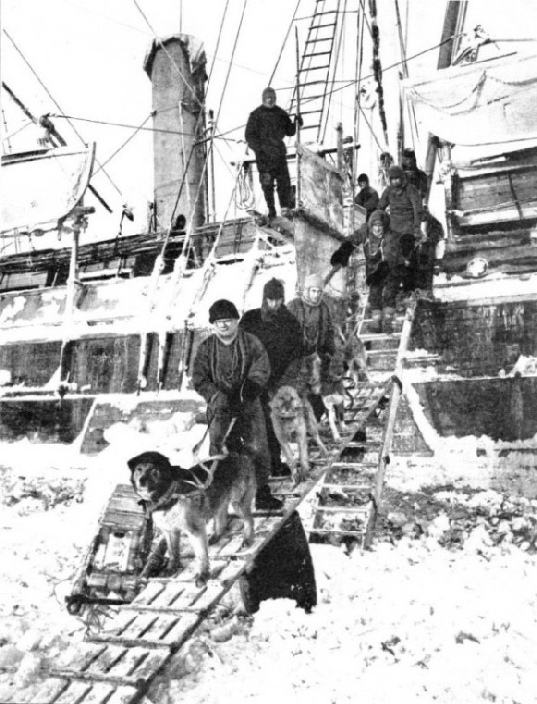
EXERCISING THE DOGS. The photograph shows George Marston leading he dogs down on to the ice floe from the Endurance. Shackleton is standing on the platform overlooking the gangway. Six teams had been formed, each having nine dogs, and considerable time and pains had been spent on their training. Each team had its leader dog whose duty it was to maintain discipline in the team by punishing disobedience or shirking. Crean, Hurley, Macklin, Marston, Mcllroy and Wild were in charge of the respective teams, and each man was responsible for exercising, training and feeding his own dogs.
Shackleton picked his little crew with great care. His first choice was Worsley - a born seaman and a fine navigator. Crean (who had won the Albert Medal in Scott’s last expedition) and McCarthy, the ship’s carpenter, came next, and then two of the hands - Vincent and McNeish. The chosen boat was the James Caird - a 23-ft. “Whaleboat”, with pointed stern.
McCarthy decked her, as far as possible, with an extempore covering of three-ply wood and frozen canvas, thawed out, foot by foot, on the blubber stove. On April 24 she was towed out through the breakers, and sail was hoisted amid cheers from the shore. She began one of the greatest boat-voyages ever made.
For sixteen days her crew fought their way towards South Georgia through mountainous seas, while undergoing every conceivable form of hardship and discomfort. For those off duty, sleep, except in snatches, was out of the question - the boat was never still for an instant, nor was there a dry square inch inside her. The cold was intense.
On the fifth day out a furious gale compelled the crew to heave-to. When it abated they had to spend hours of painful toil in freeing the James Caird from the heavy load of ice which had formed all over her. Then the weather improved slightly; but on the eleventh day, just before midnight, they were almost overwhelmed by a colossal wave that whirled them skyward and raced by, leaving the boat half-full of water. “During twenty-six years’ experience”, wrote Shackleton, who was at the tiller, “I have not encountered a wave so gigantic”.
On May 6 Worsley managed to “shoot the sun”, and made out that they were within a hundred miles of South Georgia. In two days, if the wind held, they ought to sight it. If they missed it - and in such circumstances the most experienced navigator might be forgiven for missing it - there was no hope for them, or for their comrades. They could never beat back to South Georgia.
On May 8 signs of land began to appear - floating seaweed and cormorants, which never go far from shore. A little after noon the black cliffs of South Georgia came in sight at last. The party could not land that night; and next morning a violent north-westerly gale broke on them. Setting what sail they could, they clawed desperately off the invisible, iron-bound coast. Their escape was little short of miraculous - just after the gale had eased, the pin securing the boat’s mast fell out. It must have been on the point of doing this all through the storm. If it had, nothing could have saved them; the mast would have snapped. Next morning (May 10) they at last reached, with great difficulty, the shelter of a tiny cove. All six were so weak that their united efforts failed, until food and rest had revived them, to haul the little James Caird up clear of the surf.
Though they had won through to South Georgia, they were still far from help. They were on the south-western side of the island, which is devoid of whaling stations and rarely visited. Stromness station, their objective, was still 150 miles off, by sea, and Shackleton gravely doubted whether the James Caird could ever be got there. He decided, instead, to attempt a feat never accomplished before or since - to cross South Georgia overland. To penetrate even a short distance into the interior called for full climbing equipment and much Alpine experience; Shackleton - thinking only of his twenty-two men on Elephant Island who trusted him to bring help as soon as possible - decided to attempt the crossing with only the scanty resources afforded by the James Caird's stores.
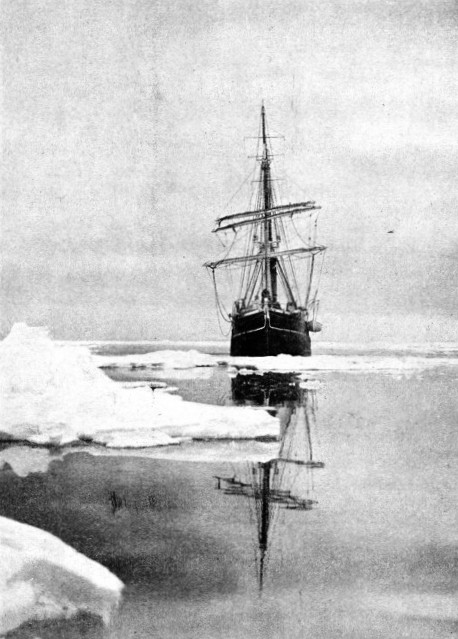
THE AURORA, the supporting ship of Shackleton’s expedition, homeward bound after rescuing the Ross Sea shore-party. In May 1915, the vessel was blown out of McMurdo Sound and left a party of ten behind. When Shackleton reached New Zealand in December 1916, he found that the Aurora had been refitted and was to be sent out again to the Ross Sea to rescue the marooned men. Three men had lost their lives, but the remaining seven were found in good health by the Aurora and were embarked without difficulty.
They rested for three days, during which a storm carried off the boat’s rudder. But this, with all the Atlantic open to it, came bobbing back into their cove on the next tide, and was reshipped. Then they shifted camp to the head of King Haakon Bay, and Shackleton, with the two fittest men - Worsley and Crean - set off on the next lap of their great adventure. They took no sleeping-bags, and went in the lightest of marching-order. They had three days’ food, a cooking stove, the carpenter’s adze (for use as an ice-axe) and a 90-ft. rope. A few screws extracted from the James Caird, and inserted in the soles of their boots, made the best available substitute for crampons (iron spikes).
Two hours’ hard climbing saw them 2,500 feet above the sea. Then they roped up, and went forward among holes and crevasses, painfully breaking trail through the soft snow. A slow descent down a huge glacier brought them to the head of Possession Bay - on the eastern side of the island but a long way from Stromness - and after turning back up the glacier they headed southeastward along the line of the coast.
Difficulties of every kind were met. Ice-inclines at an angle of 45° had to be scaled by cutting steps with the adze; fogs rolled up in front and behind; crevasses abounded. The three toiled painfully on, marching all night and pausing only for an occasional snatch of hot food. Each of them recorded independently, afterwards, his firm conviction that during the night, when a slip would have been fatal not only to them but also to their comrades on Elephant Island, their party consisted of four. By morning they were on the heights overlooking Husvik Harbour; and at seven o’clock the almost forgotten sound of a steam whistle floated to their ears - the signal calling the whale-men to work. The three, roped together, cut their way down a slope of blue ice, taking two hours to descend 500 feet. At last they reached the lower slopes fringing Stromness Bay, and a mile and a half of comparatively easy going took them to the outskirts of the little settlement.
Two small boys and an old man ran from them at sight. This was scarcely surprising. Their beards were long and their hair was matted. Their garments had been worn for nearly a year continuously and were black with dirt from head to foot, as were the wearers. The man in charge at the wharf stuck to his post, and Shackleton asked him if Mr. Sorlle (the manager) was in the house. “Yes”, he said, and inquired who they might be.
“We have lost our ship, and come over the island.”
The man repeated this in a tone of utter disbelief, and reported to Sorlle that “three funny-looking men” were outside to see him. Sorlle emerged.
“Don’t you know me?” asked Shackleton.
“I know your voice”, said Sorlle, doubtfully. “You’re the mate of the Daisy”.
“My name is Shackleton. When was the war over?”
Rescue Attempts
Mb. Sorlle put his house at the wanderers’ disposal, and feasted them royally. Next day Worsley went round to King Haakon Bay in a whaling steamer and picked up McCarthy, Vincent, McNeish and the sturdy little James Caird (now at Dulwich College, Shackleton’s old school), while Shackleton chartered a larger steamer, the Southern Sky, for the relief of the party on Elephant Island. He sailed with her on May 23, but the island proved to be unapproachable in a steel ship as heavy pack now formed an impenetrable barrier all round the Island. After a week of fruitless effort, the Southern Sky made for the Falklands.
It was absolutely imperative, if the Elephant Island men were to be saved, that they should be got off the island before winter set in. To negotiate the pack successfully a wooden ship with a fair turn of speed was required. Shackleton cabled from Port Stanley to England and learned that the Discovery could be sent out, but would not arrive until mid-September - far too late. Various South American Governments offered help - in particular, Uruguay, who lent a little steam trawler, the Instituto de Pesca No. 1.
Shackleton left Port Stanley in her for Elephant Island on June 10 - but the pack round the island defied all his efforts. With only three days’ coal left, he was compelled to abandon the second rescue attempt, and he reached Port Stanley with empty bunkers and engines breaking down.
Nothing daunted, he crossed to Punta Arenas on the Strait of Magellan, where the local British colony raised £1,500 to charter an auxiliary schooner, the Emma, for a third attempt. Towed southward by the Chilean steamer Yelcho, the Emma proceeded independently on reaching the edge of the pack. But her engines developed one defect after another, and persistent head-winds blocked all chance of her reaching the island, through the pack, under sail alone. By August 8, Shackleton had been compelled to return to Port Stanley.
Shackleton had the Emma towed back to Punta Arenas by the Yelcho. Then, as a last hope, he obtained the Chilean Government’s permission to take the Yelcho, on his promising that he would keep her clear of the ice - a necessary precaution, as she was steel-built and quite unsuitable for work in the pack. He sailed on his fourth rescue attempt on August 25.
Meanwhile, the party on Elephant Island had contrived to exist, but they were in desperate straits. Under Wild’s invaluable leadership, they had managed to build a low, stone shanty, roofed with the two boats. There, in almost complete darkness and indescribable filth, the party had spent four and a half purgatorial months. The James Caird had sailed on April 24. On August 30, 1916, the men were assembling for lunch - boiled seal’s backbone, limpets and seaweed: they had only four days’ food in hand - when suddenly they heard the report of a gun. Rounding an islet which had hidden her from view came a small steamer, flying the Chilean flag. It was the Yelcho.
“The Boss is Safe!”
Weld put a pick through their last tin of petrol and lit a flare. Then they stood in groups, watching a boat being lowered. Down the ladder climbed a familiar figure, and a cheer went up from the castaways, mingled with heartfelt murmurs of “Thank God, the Boss is safe!”
By the luckiest of chances a southerly gale had cleared the pack away from Elephant Island just before the Yelcho had arrived. There was not a moment to waste, and Shackleton headed for the island, at full speed, through thick fog. When this cleared, Worsley’s keen eyes had picked up the camp - almost invisible under its coating of snow - and within half an hour the Yelcho was heading northward with every man of the Elephant Island party.
Shackleton had good reason to regard the saving of the Endurance’s crew as the biggest thing he ever did. The ship was beset in January 1915 - she sank, hundreds of miles from land, in November - and, ten months later still, every man who had sailed in her was back in civilization, ready to serve his country in the war.
One rescue remained to be effected - that of the Ross Sea party. As already stated, the Aurora was blown out of McMurdo Sound in May, 1915, leaving behind the shore-party. This consisted of ten men. The ship, more fortunate than the Endurance, drifted for a year while beset, and ultimately escaped from the pack at the cost of a seriously-damaged rudder, which compelled her immediate return to New Zealand.
The shore-party, although short of stores and equipment - much of these being on board the Aurora - continued in spite of all difficulties their work of depot-laying.
When Shackleton reached New Zealand in December 1916, he found that the New Zealand Government had already organized a relief expedition to the Ross Sea, and had arranged to send the Aurora - now refitted - back to McMurdo Sound. To avoid last-minute changes, Shackleton volunteered to go as a supernumerary, in charge of any land operations that might be required. On arrival at Ross Island, the last remnant of the Trans-continental Antarctic Expedition was found and embarked without difficulty.
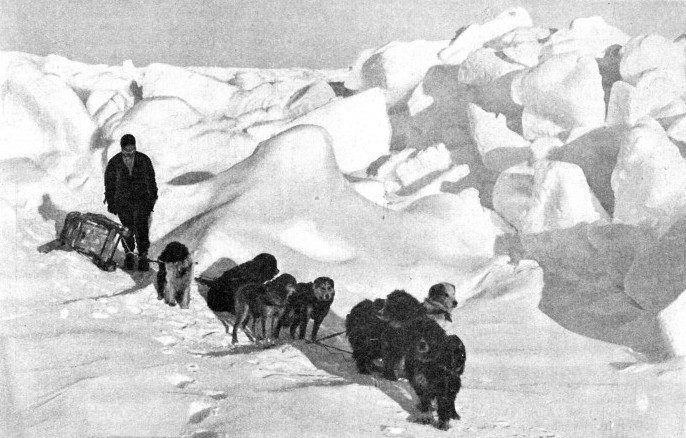
ESKIMO DOGS, OR HUSKIES, play an important part in most Antarctic and Arctic expeditions. They generally supply the tractive power and are yoked together, frequently in eights, to the sledges on which the party’s tents, gear, and provisions are carried. On his previous expedition of 1907-1909, Shackleton used Manchurian ponies for the bulk of sledge-hauling, although he took some dogs with him. For his 1914-1916 expedition, he relied solely on dogs. Huskies are closely related to the wolf, which the majority resemble in colour, although a number are black and white. They are characterized by sharp muzzles, upright ears, rough coats and bushy tails. Several dogs on this expedition were named after the English and Scottish public schools that had contributed to the cost of the dog teams.
You can read more on “The Franklin Mystery”, “Scott’s Gallant Failure”, “To the Uncharted South” on this website.









